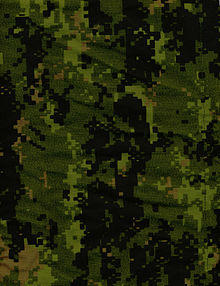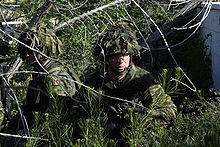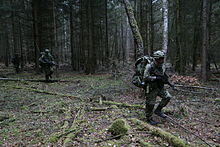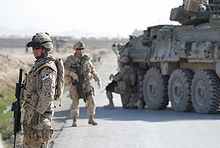| Canadian Disruptive Pattern | |
|---|---|
 CADPAT TW fabric | |
| Type | Military camouflage pattern |
| Place of origin | Canada |
| Service history | |
| Used by | Canada |
| Wars | War in Afghanistan (2001–present) |
| Production history | |
| Produced | 2002–present |
| Variants | See § Pattern variations |
Canadian Disruptive Pattern[1] (CADPAT; French: dessin de camouflage canadien, DcamC)[2] is the computer-generated digital camouflage pattern first issued in 2002, and currently used by the Canadian Armed Forces (CF). CADPAT TW is designed to reduce the likelihood of detection by night vision devices.[2]
History
Canada's desire for a new soldier system dates back to November 1988 and closely followed efforts in many NATO countries. The first research effort, called Integrated Protective Clothing and Equipment (IPCE) Technology Demonstration, was initiated in 1995 but then was cancelled, due to high systems cost and failure to meet the majority of the requirements. Ongoing operations in the mid-1990s led to the creation of the Clothe the Soldier (CTS) Project, which directly addressed the NATO soldier system capability areas of survivability and sustainability. The Canadian Disruptive Pattern was a part of ongoing research and implemented during the CTS Project.[3]
The use of CADPAT AR overseas was first reported in Afghanistan when Taliban prisoners of war were seen escorted by armed Canadian commandos in the camo. This nearly made things complicated for the Department of National Defence, since it had said that no Canadian commandos were officially in Afghanistan.[4][5] The use of CADPAT TW was reported in September 2001 with Canadian soldiers serving under PALLADIUM ROTATION 09.[5]
In 2019, tests were conducted for plans to eventually replace CADPAT in service with the Canadian Forces.[6][7] Under the Soldier Operational Clothing and Equipment Modernization (SOCEM) project, the DND will seek feedback and advice from users of the trial camouflage known as Prototype J before a decision is made in 2022. A new camouflage pattern would be adopted by 2027.[8]
Pattern variations

In development for the better part of a decade, the pattern comes in three varieties: temperate woodland (TW), arid region (AR), and winter/arctic (WA). The temperate woodland pattern became the standard issue for the Army in 2002, with the Air Force following suit in 2004. Uniforms and equipment in CADPAT material replaced the olive green material in use since the early 1960s.
Temperate woodland
The temperate woodland (TW) pattern has four specific colours—light green, dark green, brown, and black—and was first introduced in 1996 on the helmet cover for the new CG634 helmet then coming into service. At the same time, the pattern was also introduced on a new soldier's individual camouflage net. The CADPAT TW uniform allows Canadian soldiers protection from observation by the naked eye and night vision devices.
Arid regions
Concurrent with the trials of CADPAT TW, work was carried out to identify a uniform for operations in desert, near desert, and savanna environmental conditions. This three-colour pattern, known as CADPAT arid regions (AR), incorporates three different colours of brown. The CADPAT design for arid regions has been approved, and the transfer of this digital technology is ongoing to the textiles industry. CADPAT AR also features two additional arm pockets and Velcro on the arms compared to the TW uniform. In light of the deployment of the Immediate Reaction Force to Afghanistan, the CADPAT AR project was expedited with the intent that it would be issued to soldiers in summer 2002.[5]
Winter/arctic
The winter/arctic pattern was introduced as an upgrade to the monochrome winter whites to further enhance the Canadian soldier's camouflage capability by day and night. It includes near infra-red (NIR) technology.[9]
Urban
Defence Research and Development Canada based at CFB Suffield (DRDC-S) has a requirement to develop a new urban pattern for the Canadian Forces based on the three major metropolitan areas of Canada: Toronto, Vancouver, and Montreal. This new pattern is known as the Canadian urban environment pattern (CUEPAT).[10]
References
- ^ "Plan to outfit Canadian troops with U.S. uniforms a waste of $500M: top camouflage designer". National Post. Retrieved Aug 22, 2020.
- ^ a b CADPAT on the Canadian Army website
- ^ "Canada turns need into reality". Retrieved 2008-07-23.
- ^ http://www.hyperstealth.com/Hyperstealth-Summary-Canadian-Forces-camouflage-change-to-Multicam.pdf
- ^ a b c "CADPAT TW Camo ~ Royal 22e Régiment". May 25, 2019. Retrieved Aug 22, 2020.
- ^ "Canadian military tests new camouflage uniform as replacement for iconic pattern in use since early 2000s". National Post. Retrieved Aug 22, 2020.
- ^ "New CADPAT design being tested". Sep 20, 2019. Retrieved Aug 22, 2020.
- ^ "Canadian Army - Uniform, Camouflage and Equipment Modernization Process Marches On - Soldier Systems Daily". Retrieved Aug 22, 2020.
- ^ Consoltex Archived July 17, 2010, at the Wayback Machine
- ^ "CUEPAT (Canadian Urban Environment Pattern) Trial Uniforms". www.hyperstealth.com. Retrieved Aug 22, 2020.
External links
 Media related to CADPAT at Wikimedia Commons
Media related to CADPAT at Wikimedia Commons- Clothe the Soldier Programme
- Digital Camouflage History
- CA 2442558
- US 6933023
- US D474897

